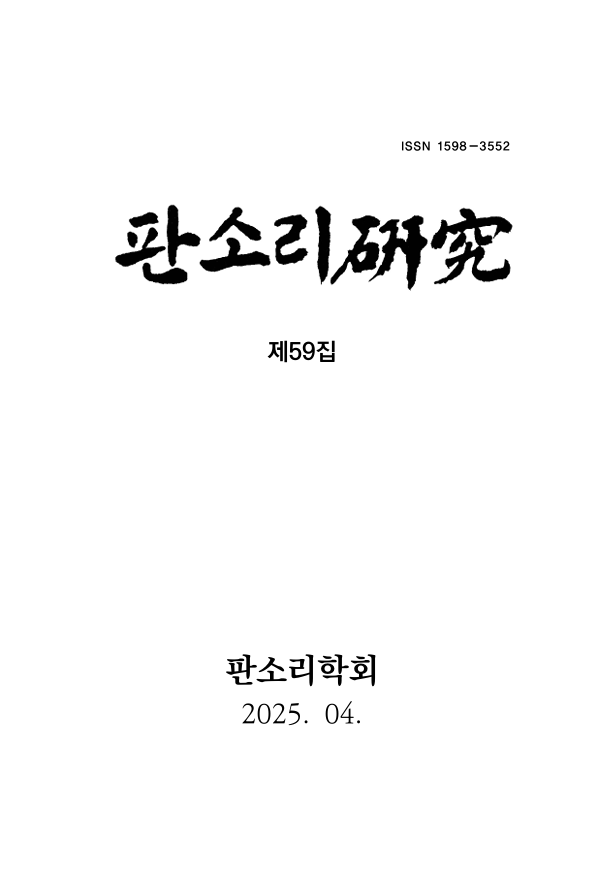- 영문명
- Lee Hwa-jung-seon Troupe and Daedong Gageukdan
- 발행기관
- 판소리학회
- 저자명
- 백현미(Hyun mi Baek)
- 간행물 정보
- 『판소리연구』제59집, 119~144쪽, 전체 26쪽
- 주제분류
- 인문학 > 언어학
- 파일형태
- 발행일자
- 2025.04.30
5,920원
구매일시로부터 72시간 이내에 다운로드 가능합니다.
이 학술논문 정보는 (주)교보문고와 각 발행기관 사이에 저작물 이용 계약이 체결된 것으로, 교보문고를 통해 제공되고 있습니다.

국문 초록
이화중선은 1920-30년대 활동한 대표적인 여류 명창인데, 그녀의 음반 녹음과 라디오 방송 이외의 활동에 대한 연구는 거의 이뤄지지 않았다. 본고에서는 그녀가 속한 기생조합과 지방 공연 상황을 밝혀, 남도 음악가이자 공연 예술인으로서의 특징을 강조했다. 그녀는 경성에서 성공한 ‘남선 명기’였다. 이화중선은 군산과 남원의 기생조합에 적을 두고 학습하면서 기량을 쌓았고, ‘남선 명기’로 경성에 진출한 후에는 조선권번과 한남권번을 대표하는 명창으로 활동했다. 그녀는 중앙과 지방의 극장 무대를 넘나들던 공연가였다. 신문사나 축음기회사 등이 주최한 연주회에 두루 참여했고, ‘이화중선 일행’ 혹은 대동가극단으로 일컬어진 협률사를 이끌고 지방 순회 공연을 지속했다. 그녀의 협률사 활동은 다음 두 가지 의의를 지닌다. 첫째, 여성 명창 이름을 앞세운 거의 유일한 협률사로, 이전의 협률사가 주로 남성 명창 이름을 앞세웠던 것과 구별된다. 둘째, 1920-30년대에 지속적으로 활동한 거의 유일한 협률사라는 점이다. 남도 음악가들이 조선음률협회나 조선성악연구회와 연계된 채 경성에서 활동하던 1930년대에도, 이화중선은 협률사를 이끌고 각지를 돌며 공연했다. ‘이화중선 일행’을 통해 협률사의 전통이 이어졌다.
영문 초록
Lee Hwa-jung-seon was a prominent female master singer (myeongchang) active in the 1920s and 1930s. However, research on her activities beyond her records and radio broadcasts are scarce. This paper sheds light on her affiliations with gisaeng associations and her performances in regional areas, emphasizing her characteristics as a southern musician and performing artist.
She was a successful Namsun Myeonggi (renowned gisaeng of the southern region) in Gyeongseong (modern-day Seoul). Lee Hwa-- jung-seon honed her skills while being affiliated with the gisaeng associations of Gunsan and Namwon. After advancing to Gyeongseong as Namsun Myeonggi, she became a leading master singer representing both the Joseon Gwonbeon and Hannam Gwonbeon.
She participated widely in concerts organized by newspapers and phonograph companies and led touring performances under the name Lee Hwa-jung-seon Troupe or as part of the Daedong Gageukdan (Daedong Opera Troupe). Her activities with this troupe have two significant implications. First, it was one of the very few performance troupes that prominently featured a female master singer’s name, distinguishing it from previous troupes that were typically led by male singers. Second, it was one of the only troupes that operated continuously throughout the 1920s and 1930s. Even in the 1930s, when southern musicians were primarily engaged with organizations such as the Joseon Music Association and Joseon Vocal Music Research Society in Gyeongseong, Lee Hwa-jung-seon continued to lead her troupe on nationwide tours. Through the Lee Hwa-jung-seon Troupe, the tradition of the hyeopryulsa (traveling performance troupe) was sustained.
목차
1. 들어가는 글
2. 군산부군창예기조합에서 한남권번으로
3. ‘이화중선 일행’에서 대동가극단으로
4. 나오는 글
키워드
해당간행물 수록 논문
- ‘이화중선 일행’과 대동가극단
- ≪매일신보≫ 소재 <강상련>과 <심청전>의 관계를 통해 본 <강상련>의 전승사적 의의
- 박월정의 판소리를 통해 살펴본 판소리 창작의 범주와 경계
- 동초제 <흥보가> ‘놀보 박타령’이면 연구
- Andrei Serban의 <다른 춘향>의 연출 기법과 창극사적 의미
- 김인순 『춘향』 속 ‘오색(五色)’의 효과 및 의미
- 판소리 교육용 디지털 매체의 현황과 활용 - 국립국악원 e-국악아카데미를 중심으로
- 장판개 바디 <수궁가>의 서사적 특징 분석 - 정순임, 박초월 창본의 비교를 통해
- 판소리연구 제59집 목차
- '완창 판소리’의 성립 및 성장 배경과 오늘날 판소리 완창의 방향성 고찰
- 임진택 창작판소리에 대한 문학적 접근 2: 증언 판소리를 대상으로
참고문헌
관련논문
인문학 > 언어학분야 BEST
- ChatGPT 기반 TOPIK 말하기 평가피드백 모형 개발 및 적용
- AI 기반 피드백의 교육적 활용 가능성 탐색
- 넷플릭스 <케이팝 데몬 헌터스>를 통해 본 K-컬처의 전지구적 확장과 K-헤리티지의 실천적 재구성
인문학 > 언어학분야 NEW
- Successive-Increase Reading of Tasi ‘Again’ in Korean
- On the Constituency of Numeral and Classifier in Korean
- Chance and Necessity in Language Evolution
최근 이용한 논문
교보eBook 첫 방문을 환영 합니다!

신규가입 혜택 지급이 완료 되었습니다.
바로 사용 가능한 교보e캐시 1,000원 (유효기간 7일)
지금 바로 교보eBook의 다양한 콘텐츠를 이용해 보세요!



